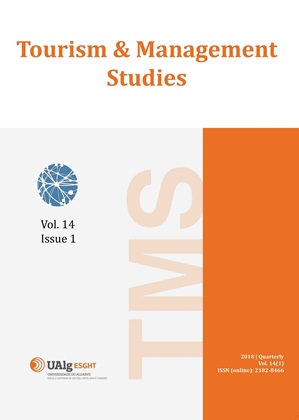Tourism, cultural activities and sustainability in the Spanish Mediterranean regions: A probit approach
Keywords:
Tourism, cultural activities, sustainability, probit models, tourism policyAbstract
Culture is the preferred activity of sun & sand tourists visiting the Spanish Mediterranean regions. Improving our knowledge on the factors surrounding this type of demand appears to be pivotal for the continuous renewal of those mature destinations. With this objective we apply probit models to a data set of more than 200,000 questionnaires accounting for the socio-economic characteristics of the tourists, their trip behaviour, and destination and time fixed effects. Results allow us to identify interesting characteristics of tourism of cultural activities making this product a good candidate to contribute to the sustainability of destinations.
References
AEC (2015). Anuario de Estadísticas Culturales (2015). Madrid: Ministerio de Educación, Cultura y Deporte de España.
ETC (2005). City Tourism and Culture. Brussels : European Travel Commission.
Europa Nostra (2016). Retrieved 16 June 2016 from http://www.europanostra.org/attracting-new-tourists-flows-ensuring-protection-cultural-heritage/
European Commission (2007). Agenda for a sustainable and competitive European tourism. COM Document (2007), 621 final, Brussels: Commision of the European Communities.
Getz, D. (2008). Events tourism: Definition, evolution and research. Tourism Management 29, 403–428.
Hjalager, A-M., & Richards, G. (2002) (eds.). Tourism and Gastronomy. London: Routledge.
May, J. (1996). In search of authenticity off and on the beaten track. Environment and Planning D: Society and Space, 14(6), 709–736.
McKercher, B., & du Cros H (2002). Cultural Tourism: The Partnership between Tourism and Cultural Heritage Management. New York: The Haworth Hospitality Press.
OECD (2009). The Impact of Culture on Tourism. Paris: OECD.
OECD (2014). Tourism and the Creative Economy. Paris: OECD.
Richards, G. (1996). Cultural Tourism in Europe. Wallingford: CABI.
Richards, G. (2001). Cultural Attractions and European Tourism. Wallingford: CABI.
Richards, G. (2011). Creativity and tourism: The state of the art. Annals of Tourism Research, 38(4), 1225–1253.
Richards, G., & Palmer, R. (2010). Eventful Cities: Cultural Management and Urban Revitalisation. London: Routledge.
Richards, G., & Wilson, J. (2006). Developing creativity in tourist experiences: A solution to the serial reproduction of culture? Tourism Management, 27(6), 1408–1413.
Ritzer, G. (1999) Enchanting a Disenchanted World: Revolutionizing the Means of Consumption. London: SAGE Publications.
Stone, P. R. (2006). A dark tourism spectrum: Towards a typology of death and macabre related tourist sites, attractions and exhibitions. TOURISM: An Interdisciplinary International Journal, 52(2), 145-160.
Timothy, D. J., & Boyd, S. W. (2003). Heritage Tourism. London: Pearson Education.
UNWTO (1985). The Role of Recreation Management in the Development of Active Holidays and special Interest Tourism and the Consequent Enrichment of the Holiday Experience. Madrid: United Nations World Tourism Organization.
UNWTO (2014). World Tourism Organization Annual Report 2013. Madrid: United Nations World Tourism Organization.
Wooldridge, J. M. (2010). Econometric Analysis of Cross Section and Panel Data. Cambridge (Mass): The MIT Press.
Downloads
Published
Issue
Section
License
Copyright (c) 2018 Tourism & Management Studies

This work is licensed under a Creative Commons Attribution-NoDerivatives 4.0 International License.
The journal retains published articles’ copyrights, but they are simultaneously licensed under the Creative Commons Attribution License (CC BY-NC-ND), which allows individuals’ to share the relevant papers as long as authorship and publication in this journal are duly acknowledged.



